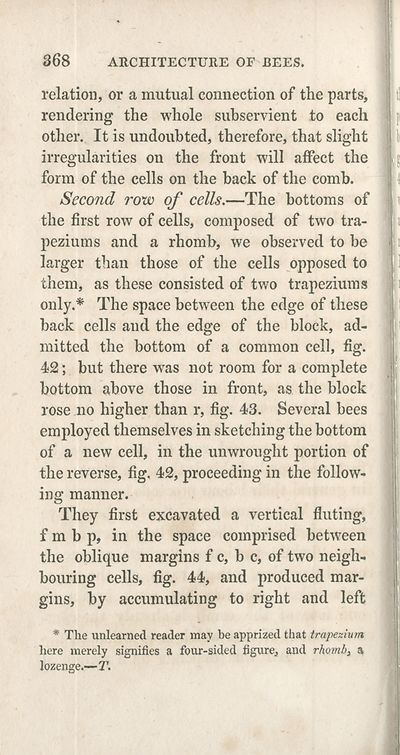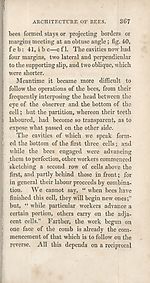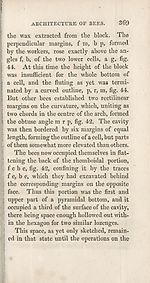Download files
Complete book:
Individual page:
Thumbnail gallery: Grid view | List view

368 ARCHITECTURE OF BEES.
relation, or a mutual connection of the parts, f
rendering the whole subservient to each I
other. It is undoubted, therefore, that slight j>
irregularities on the front will affect the 1
form of the cells on the back of the comb.
Second row of cells.—The bottoms of \
the first row of cells, composed of two tra¬
peziums and a rhomb, we observed to be
larger than those of the cells opposed to
them, as these consisted of two trapeziums |
only.* The space between the edge of these i
back cells and the edge of the block, ad¬
mitted the bottom of a common cell, fig.
42; but there was not room for a complete
bottom above those in front, as the block
rose no higher than r, fig. 43. Several bees
employed themselves in sketching the bottom
of a new cell, in the unwrought portion of
the reverse, fig, 42, proceeding in the follow¬
ing manner.
They first excavated a vertical fluting,
f m b p, in the space comprised between
the oblique margins f c, b c, of two neigh¬
bouring cells, fig. 44, and produced mar¬
gins, by accumulating to right and left
* The unlearned reader may be apprized that trapezium
here merely signifies a four-sided figure, and rhomb, a
relation, or a mutual connection of the parts, f
rendering the whole subservient to each I
other. It is undoubted, therefore, that slight j>
irregularities on the front will affect the 1
form of the cells on the back of the comb.
Second row of cells.—The bottoms of \
the first row of cells, composed of two tra¬
peziums and a rhomb, we observed to be
larger than those of the cells opposed to
them, as these consisted of two trapeziums |
only.* The space between the edge of these i
back cells and the edge of the block, ad¬
mitted the bottom of a common cell, fig.
42; but there was not room for a complete
bottom above those in front, as the block
rose no higher than r, fig. 43. Several bees
employed themselves in sketching the bottom
of a new cell, in the unwrought portion of
the reverse, fig, 42, proceeding in the follow¬
ing manner.
They first excavated a vertical fluting,
f m b p, in the space comprised between
the oblique margins f c, b c, of two neigh¬
bouring cells, fig. 44, and produced mar¬
gins, by accumulating to right and left
* The unlearned reader may be apprized that trapezium
here merely signifies a four-sided figure, and rhomb, a
Set display mode to:
![]() Universal Viewer |
Universal Viewer | ![]() Mirador |
Large image | Transcription
Mirador |
Large image | Transcription
| Antiquarian books of Scotland > Curiosities & wonders > New observations on the natural history of bees > (402) |
|---|
| Permanent URL | https://digital.nls.uk/128810691 |
|---|
| Description | Thousands of printed books from the Antiquarian Books of Scotland collection which dates from 1641 to the 1980s. The collection consists of 14,800 books which were published in Scotland or have a Scottish connection, e.g. through the author, printer or owner. Subjects covered include sport, education, diseases, adventure, occupations, Jacobites, politics and religion. Among the 29 languages represented are English, Gaelic, Italian, French, Russian and Swedish. |
|---|

